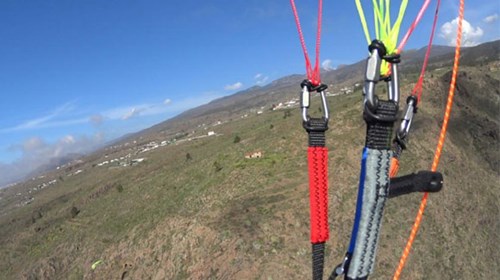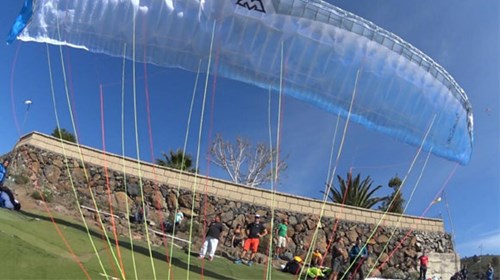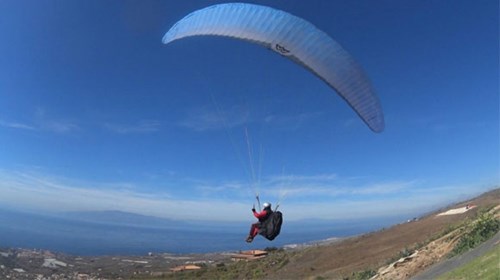The Eden 6 is a great wing, giving enormous pleasure. Its the "Bird of Paradise" in 6th generation. A switch from Eden 5 to 6 should differ only in the higher performance of the new sail. The new Mac Para Eden 6 has an overall balanced and manageable basic characteristic and provides a great, safe feeling in the flight (fly in peace). Even in turbulent conditions, the wing retains largely stoic and does not detract from the good feeling of flight. The glide of the Eden 6 is at the top of the current B segment. The manufacturer claims a glide ratio of 10+. This seems to be no dreamy optimism, but is according to our experience, corresponding to the reality.
Report by Jürgen Karthe
At first it seemed impossible to get a the very first Eden 6 of Mac Para in my hands, but the manufacturer and importer in Germany finally made it possible. Here are our first impressions.
Tenerife - to 9 days in crisp January thermals
The new leading edge of Eden 6 discloses good performance and the line concept is modern and manageable.
The previous Eden 5 was constructed without 3D Shaping. The new Eden 6 has now an optimized profile with this technique. Compared to its predecessor the projected AR has increased a few decimal values (from 5.6 to 5.91). The line concept too has has been completely revised. The Eden 6 now is now a pure three liner.

The Risers are narrow belts and tend, because of the used material stiffness, not to twist. On the belts, the different parts are set off by colored markings. Since the red A-lines are contrasting, you have a perfect overview, lying out the glider and in the preflight check. This is exemplary for the safety. The other few main lines are yellow.
Up to and including the middle gallery the lines are sheathed. The upper gallery lines are made of unsheathed Liros. The line concept is exemplary and we have nothing to criticize.
The handles are made of colored material and do not have a grip strip, a feature that is handy for me. They are not adjustable in width, but fit good over the gloves. Between strap and brake-line there is a vortex, which works fine against twisting.
On the risers there are no C-handles whats how ewer, but pulling on the C works just as good. The accelerator has high quality ball-bearing pulleys, so that the whole construction gives an impression being elaborated and of perfect quality.
The only slight criticism is the push-button to lock the handles to the risers. With sand and dust, it could get quite difficult to close because they are very hard locking. But this also has its advantage: the handles are not inadvertently loosening by themselves.
The maillons of the Eden 6 are made of the known triangle carabineers. The lines are held in place by a rubber.
All in all, the risers are perfect and lead into a truly modern line concept.
As mentioned before, the Eden 6 comes now with a leading edge with 3D shaping. The leading edge has been completely redesigned: moderate shark nose and profile reinforcing chopsticks reflect a modern, performance optimizing design. Of course, the Minirips of its predecessor at the trailing edge are there too.
The quality of the production is, typically Macpara, very high. All the sutures are very clean and inside the profile. The trailing edge is stitched with a mylar tape.
The wing can easily be packed.
Another new feature is a supplied wing bag, made of durable materials.

As mentioned before, the layout of the glider is very clear, so the start pulling the red A-lines - and the filling performance is as easy as can be.
The Eden 6 starts very easily thanks to the shaping rods. He fills evenly over the whole wing and shows no trend to form a rosette. The inflation is pleasantly smooth. The ascent is moderately fast and evenly until the top.
Here the wing shows no tendency to pitch, no matter how strong or how lateral the wind is coming from. A light brake input holds the wing over the pilot.
The start behavior is exemplary and easy. The Eden was started at week and strong winds, as well as in slight crosswind. Even with a slight crosswind the wing can be started straight and then easily turned into the wind. The lift-off speed was rated by us as average to low.
First: the feeling in flight gives a the great sense of security, an impression which is known from the Eden 5. Starting with the first "airkiss"
we felt relaxed and well under the wing.
The flights showed a very reliable and subdued track behavior in all axes.
The brake pressures is low and the first impression is "not having any pressure at all" on the brakes, since the brakes have almost 30 percent no resistance. But then the pressure is significantly and progressively increasing. Although it gave the impression - the wing does not have much idle breaks, it brakes up progressively. Here, the entire trailing edge of the corresponding side is hinged. The concept is already known from the previous model. The brakes have no differentiated attachment on the trailing edge.
Because of this progressiveness of the brake, the whole wing appears calm and initially somewhat "sedate". The pilot, however, gets used fast to this behavior and quickly appreciates this positively. As a whole, it produces a wonderfully pleasant flight feeling. The pilot can thereby control the wing in a way as he likes, a quality that is very handy and accommodating for the leisure pilot. Are vehement maneuvers needed, you have to briefly pull the brake up to 50 percent in order to produce crisp and athletic moves. In principle, the wing should, however, be flown without brake input, because in trim speed, the Eden 6 has his best glide - a glide that is very good and and easily as good as the top wings in his class.
It's incredibly fun to fly away with the Eden 6. On glides I arrived mostly higher than I had expected before. The Eden 6 "makes meters". The trim speed I averaged is 38 km/h which is not particularly fast, but the distinctively good glide compensates easily the missing 2 km/h compared to the competition.
The Eden 6 takes thermals very well, does not tend to yaw or pitch back. It is easy even in stronger thermals. The Eden 6 shows the core of the thermal moderately but significantly through the risers. During the subsequent roll in, the wing shifts slightly and you have to support him into it. This by proper input through brake and weight. Also in re-centering the thermals, adjustments with input is necessary, because else the wing tries to straiten out. Also, the thermal flight is very relaxed. Entering the thermal the wing nods only moderately and tends not to undercut. Very fast we got "the feeling for the wing" and could top anytime. After a short time the wing then almost was no longer perceived, as it can maneuver very quiet and precise.
The so-called "diging" showed by the predecessor was no longer detectable in the Eden 6.
The profile of Eden 6 is very resistant to collapse. Still, in the partly rough conditions in Tenerife, it happened. Lateral collapses happen without giving big punches to the pilot. They vanish as fast as they arrive.
Sometimes a collapse was merely heard by rustling. Thanks of the big pressure in the central parts of the wing, it is truly very resistant to collapses. No mentionable tucking after collapses could be perceived, nor was there any significant change of course or a big intervention needed to keep the cap on direction. The opening process was quick and cell by cell, usually without affecting the smooth running of the sail.
The Frontstall across the entire front was unremarkable. The wing reopened quickly and without deformations. There were no complications.
The accelerator of Eden 6 can be operated smoothly and the needed pressure is small. From 40 km/h ground speed we managed a speed increase by 11 - 12 km/h roll to roll. This corresponds roughly to the manufacturer's specification with max. 52 km/h. The wing accelerated flies stable and shows not flapping.
The flat polar of the wing fully accelerated, is very enjoyable. So the sinking speed fully accelerated was only 1.3 meters (average).

Big ears are pulled without much resistance from the wing. They are easy to hold and do not "hit". The opening is delayed and uniformly soft - cell by cell.
By pulling the brake, the opening can be accelerated. The decrease of the glide though, is only small - average value was between 0.5 and 0.6 ms. With full acceleration the sink rate came to 2.5 - 2.7 meters.
The Eden & is a feel-good wing. Accordingly, it requires input, if you would like to know him from his athletic side. With weigh shifting and good brake input, the Eden 6 flies sporty and dynamic. These is nothing there to miss!
So the Eden 6 quickly builds a spiral rotation, which can be very well controlled. However, the pilot should be careful with the brakes, because the Eden has a marked tendency to roll out independently. Sink rates up to 10 meters/s were easily to get and to hold. The roll out was easy every time without complication in at least one full circle. It is better to do it in 2 circles, since the wing as described before, has the tendency to roll out independently and then transforms dynamic into high so it can ascend into his own wake turbulence.
The maneuver is although easy to handle. We pilots had a lot of fun, because of the simplicity the maneuver.
B-Stall: was not flown.
The really good gliding of the wing requires adjustments, when switching from older wings, as you, in most cases you arrive higher than previously.
Because of its aerodynamic goodness the wing transforms glide beautifully in high, so flaring is a delight and makes a lot f fun, especially because the wing is very stable in its vertical axis. The stall point was with one wrapping at about one arm length. The stalling occurs softly.
The Eden 6 is a great wing, giving enormous pleasure. Its the "Bird of Paradise" in 6th generation. A switch from Eden 5 to 6 should differ only in the higher performance of the new sail. The new Mac Para Eden 6 has an overall balanced and manageable basic characteristic and provides a great, safe feeling in the flight (fly in peace). Even in turbulent conditions, the wing retains largely stoic and does not detract from the good feeling of flight.
The glide of the Eden 6 is at the top of the current B segment. The manufacturer claims a glide ratio of 10+. This seems to be no dreamy optimism, but is according to our experience, corresponding to the reality.
The Eden 6 is a top modern wing, constructed with value and with a pleasant price/performance ratio.
We recommend the Eden 6 to pilots who fly regularly and often, and have quite a bit of flight practice. Then it does not matter whether you come from the A-Class - or B- or you are just looking for a very comfortable wing for sightseeing. The Eden 6 is designed for longer XC trips.
The Eden 6 should be flown at least in the middle or at the weight limit.
Packsack
1 cells Packsack
1 Multi-Function Tool
1 T-Shirt
The Eden was flown by us in direct comparison with other cutting edge B-wings within identical weight class. Direct comparisons are difficult, because of the diversity of the pilot skills. But anyhow, there were no differences in performance in gliding and in thermal flights. The 6 Eden underlined his gentle basic characteristic for the target group of leisure pilots. Of course, the described flight experiences are subjective, but they are written to the best of our knowledge and belief. The review is intended solely as a guide for interested pilots. The report was written by feel-good / and cross-country pilots, independent from companies. The test pilots have a long-standing experience with various B-Class wings and are frequent flyers. If you have questions or suggestions, please let us know: "glider (at) freenet.de"
Jürgen Karthe